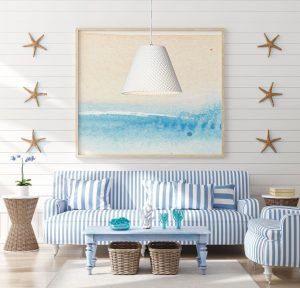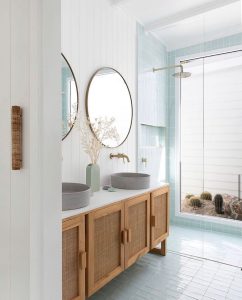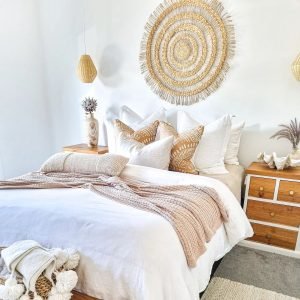There’s a reason coastal decor continues to charm its way into homes around the world. It’s more than a style. It’s a feeling. The moment you walk into a coastal-inspired home, something shifts. The air feels lighter. The colors soothe. The space invites you to breathe a little deeper and stay a little longer.
Your Ultimate Guide for Adding Coastal Decor to Every Room is here to help you bring that same feeling into your own home, no matter where you live. Whether you’re near the ocean or landlocked in the middle of the country, coastal decor is about creating a space that feels calm, fresh, and comfortably lived in.
This style isn’t about recreating a beach house cliché. It’s about choosing textures that invite touch, colors that calm the mind, and details that tell your story. Coastal design is personal, and its beauty is in the simplicity. With the right approach, every room in your home can reflect that peaceful, easygoing vibe.
In this guide, we’ll walk through each room, one by one. You’ll learn the foundational elements of coastal style, and how to adapt them to suit your space and lifestyle. Whether you’re drawn to the classic blue-and-white palette, soft neutrals, or more modern takes on coastal chic, there’s something here for you.
Understanding the Coastal Decor Style
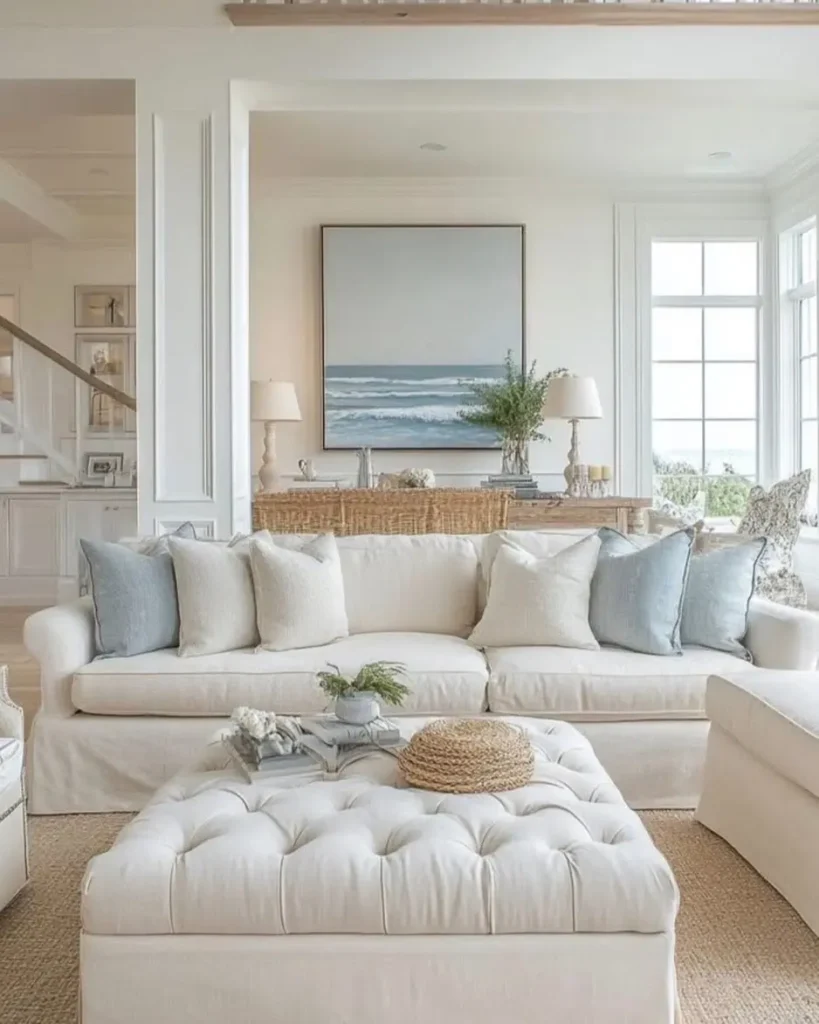
Before we jump into room-by-room ideas, let’s take a moment to understand what coastal decor really is. It’s one of those styles that’s often misunderstood, but when you get it right, it can completely transform the way your home feels.
What Is Coastal Decor?
Coastal decor is all about light, air, and ease. It’s inspired by the look and feel of life by the sea. Think soft linens, sandy tones, natural textures, and a sense of openness. This style doesn’t try too hard—it’s relaxed and unpretentious.
It often includes colors drawn from the coast: sun-bleached whites, sky blues, soft grays, and warm neutrals. You might find weathered wood, woven materials, and breezy fabrics throughout the home. Nothing should feel overly polished or forced. Instead, the spaces feel lived-in and thoughtfully gathered over time.
Coastal vs. Nautical: What’s the Difference?
People often use these terms interchangeably, but they’re not quite the same.
Coastal decor takes inspiration from the shoreline. It’s subtle, layered, and often leans minimalist. Nautical, on the other hand, is more theme-driven. It uses bold navy tones, ropes, anchors, and stripes. Nautical leans into a maritime aesthetic, while coastal feels more natural and serene.
In short: nautical is a theme, coastal is a vibe. You can absolutely blend the two, but knowing the difference helps you make more intentional design choices.
Signature Elements of Coastal Style
To design with coastal charm, look for elements that speak to texture, light, and comfort.
- Color palette: White, cream, sand, soft blue, driftwood gray, and seafoam green
- Materials: Linen, cotton, rattan, seagrass, reclaimed wood
- Lighting: Plenty of natural light, soft lamps, and woven pendants
- Accents: Shells, coral, pottery, art that reflects water or sky
These pieces should come together in a way that feels easy. Nothing should match too perfectly, and no space should feel overly decorated. The goal is to create a home that reflects calm, comfort, and the beauty of the natural world.
Coastal Decor for the Entryway
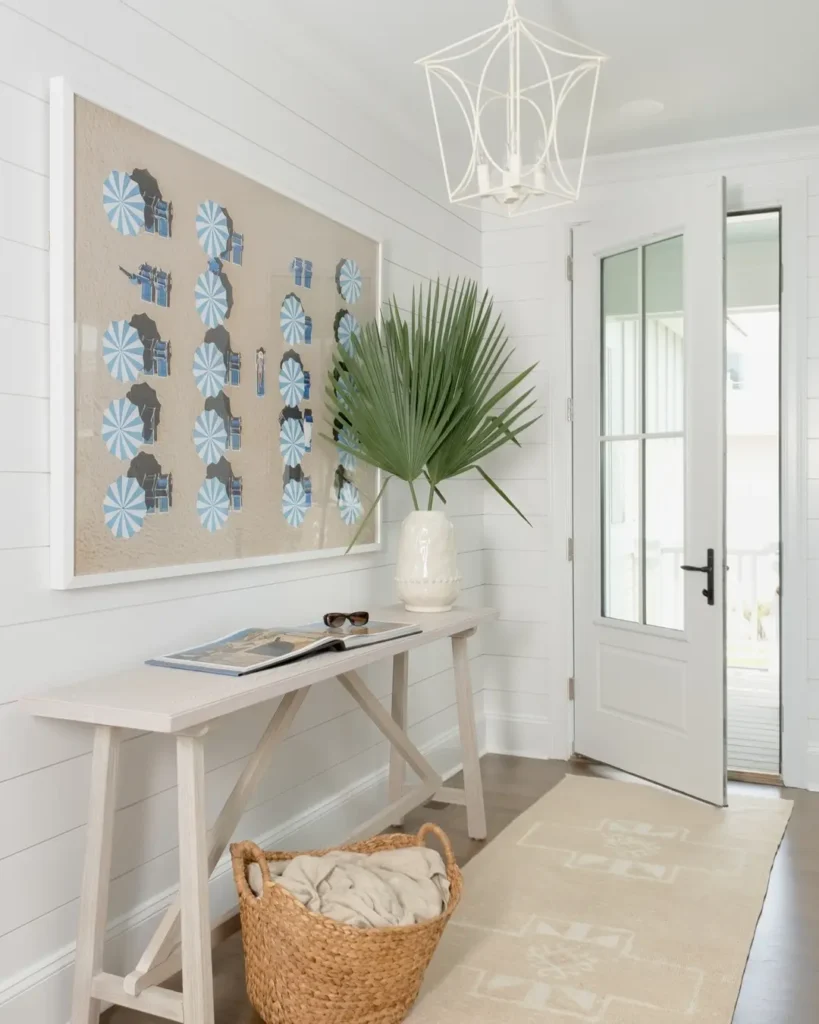
Your entryway is more than just a pass-through—it’s your first hello. It’s where your home begins to tell its story. When you decorate it with coastal elements, you’re setting a calm and welcoming tone right from the start.
Start with Natural Foundations
To give your entryway a coastal look, begin with a few grounding pieces. A weathered console table in wood or rattan instantly brings in texture. A woven basket for shoes or totes adds both style and function. A seagrass or jute rug underfoot warms up the space and hints at sandy shores.
Lighting matters here, too. If you can, include a lamp with a ceramic or glass base. Choose soft, warm bulbs that mimic natural sunlight. If your space allows, consider a woven pendant or sconce that adds a layer of interest without overwhelming the entry.
If you’re choosing furniture for this space, we break it down step-by-step in How to Choose the Perfect Coastal Console Decor for Your Home—a great read before you start styling.
Layer in Meaningful Coastal Accents
Coastal decor is at its best when it’s personal. Your entryway is a great spot to introduce small touches that reflect your own connection to the coast.
- Add a small bowl of seashells or driftwood you’ve collected.
- Hang a mirror with a whitewashed or rope frame to bounce the light around.
- Use a few favorite photos from a beach vacation, framed in simple wood or brass.
Art is another way to build character here. A print of a dune path, abstract waves, or a subtle watercolor in soft blues and neutrals brings a sense of calm without being overly literal.
You’ll find more ideas like these in our focused guide, Coastal Entryway Decor: Tips and Tricks for Capturing the Perfect Coastal Vibe. It’s full of practical ways to make this space shine.
Keep It Light, Airy, and Functional
Clutter has no place in coastal style, especially in smaller spaces like entryways. Every piece should serve a purpose—either functional or beautiful.
If you have the space, include a bench or small stool for slipping shoes on and off. Tuck baskets underneath for quick storage. A few hooks on the wall can keep bags and hats corralled while also adding to the laid-back vibe.
This is also a great place to introduce scent. A small diffuser or candle with notes of citrus, sea salt, or eucalyptus can set the mood as soon as you walk in the door.
Coastal Living Room Ideas
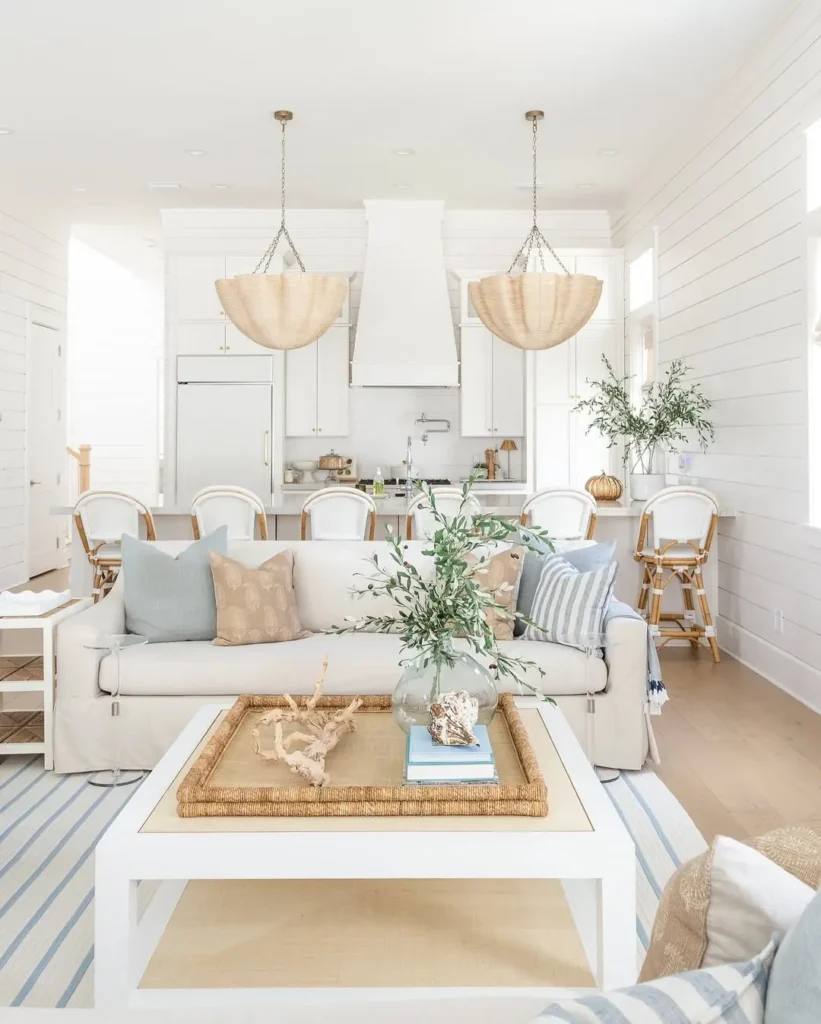
The living room is the heart of your home—it’s where your family gathers, guests linger, and everyday moments unfold. A coastal-style living room should feel easy and open. Think sunlight, soft fabrics, and furniture that invites you to relax.
Start with a Light and Breezy Foundation
A coastal living room begins with color. Stick to a palette inspired by the sea and sky. Soft whites, warm sand, driftwood gray, and ocean blues work beautifully together. These shades reflect natural light and create a calm atmosphere.
If your walls need a refresh, consider painting them a creamy white or pale blue. Floors look best in light wood, white oak, or even a soft woven rug that adds warmth underfoot without feeling heavy.
Choose Comfortable, Casual Furniture
Slipcovered sofas are a coastal classic. They’re practical, family-friendly, and give the room a relaxed look. Look for chairs made from natural fibers—like rattan, cane, or seagrass—to add texture without bulk.
When arranging furniture, keep the layout open and easy to navigate. Coastal design isn’t about filling every corner. It’s about creating space for life to happen.
Add a driftwood coffee table or a reclaimed wood console to tie the room together. If you want contrast, try a soft blue or sage-green sideboard. These pieces bring personality without straying from the coastal feel.
Layer in Texture and Personal Touches
This is where your coastal decor really comes to life. Use throw pillows in soft linen or cotton with beachy patterns—stripes, subtle florals, or ocean tones. Layer in throws in lightweight knits or washed denim shades for comfort and color.
Accessories should feel collected, not curated. A large glass vase with pampas grass or beach grass. A stack of books on coastal living. Driftwood, coral, or sea glass displayed simply on a shelf. These details make the space feel lived-in and loved.
Mirrors work beautifully here, especially with weathered frames. They bounce light around and visually expand the space. For even more inspiration, we dive into reflective styling in How to Add Mirrors to Your Coastal Decor.
Avoid Clutter and Keep It Intentional
The best coastal spaces feel effortless. That means avoiding over-accessorizing or sticking too closely to a theme. You don’t need anchors or starfish on every surface to create a beachy vibe.
If you’re aiming for a clean, minimalist look, you’ll love our post on Minimalism and Coastal Farmhouse Decor: How to Avoid a Cluttered Look. It offers helpful tips to keep your space breezy, not busy.
For a deep dive into coastal living room style, head to Coastal-Inspired Decor: Bring the Beach to Your Living Room. It’s full of ideas that blend comfort and coastal charm seamlessly.
Coastal Kitchen Style
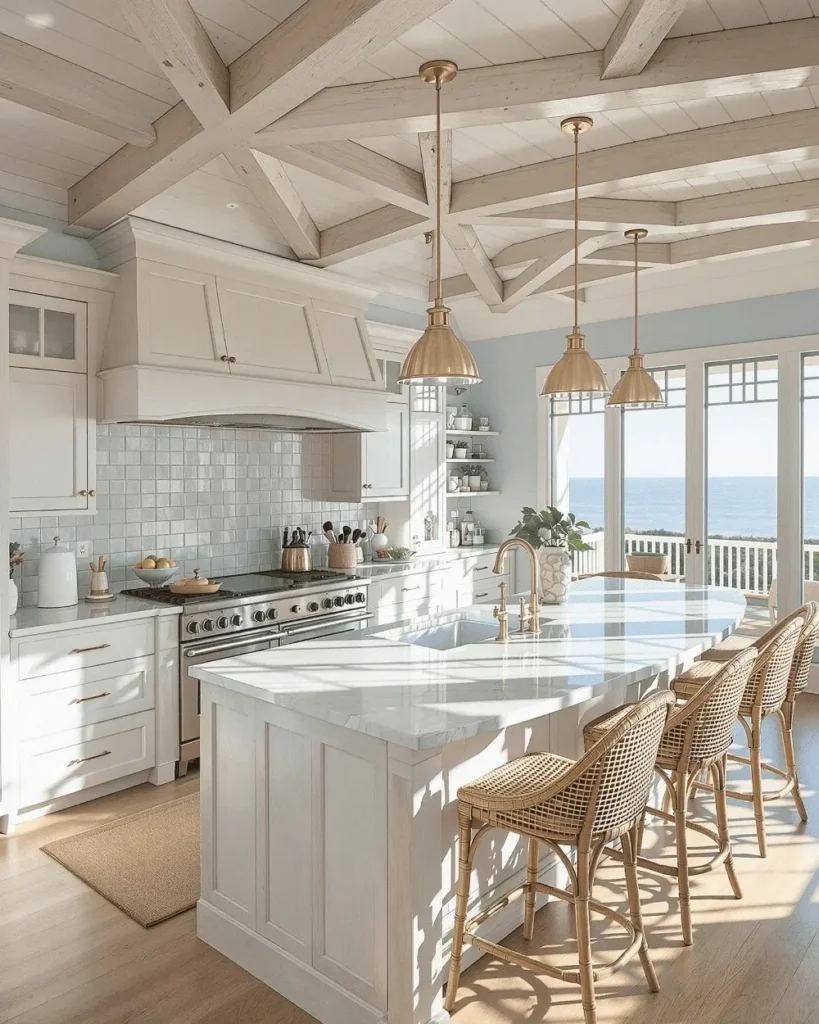
The kitchen is where meals are made, conversations unfold, and family life happens. A coastal kitchen captures all of that with an added layer of calm. It’s light, functional, and designed to feel as fresh as an ocean breeze.
Focus on Light and Simplicity
Start with the basics—walls, cabinets, and flooring. Coastal kitchens often feature white or soft-toned cabinets. Pale blue or seafoam green adds color without overwhelming the space. Pair these with simple hardware in brushed brass, matte black, or antique pewter for contrast.
Subway tile in a glossy white or pale aqua brings texture and shine to your backsplash. Want something a bit more custom? Consider sea glass mosaics or handcrafted zellige tiles for a splash of coastal personality.
Flooring should feel natural and durable. Light oak or whitewashed wood is ideal, but even tile in a soft sand or driftwood tone will work beautifully.
Open Shelving and Functional Decor
A coastal kitchen feels open and breathable. One way to get that look? Swap out a few upper cabinets for open shelves. Use them to display simple everyday dishes, woven trays, glass jars, or vintage finds.
Functional decor is key here. Think cutting boards in warm wood tones, a bowl of lemons on the counter, or a ceramic pitcher holding wooden spoons. These details feel lived-in without looking staged.
Soft linen or cotton café curtains add charm while letting in natural light. Keep window treatments minimal to preserve that bright, airy feel.
Add Natural Texture and Coastal Accents
Layer in texture with small touches. Woven pendant lights over an island or dining table create visual warmth. Barstools in rattan, bamboo, or teak add character while staying within the coastal theme.
Keep your color palette consistent with the rest of the home, but don’t be afraid to mix in soft greens, pale grays, or sandy tans. These tones help ground the space and keep it from feeling too stark.
Artwork in the kitchen? Absolutely. Choose pieces that reflect the coastal mood—beach landscapes, simple line drawings of shells, or abstract water-inspired prints.
Make It Livable and Inspiring
More than anything, your kitchen should inspire connection. Whether you’re sipping coffee on a quiet morning or gathering around the island during dinner prep, this space should feel inviting and effortless.
For a full walkthrough of how to create this look, be sure to explore Coastal Decor: How to Achieve the Modern Coastal Kitchen Look. It’s packed with styling ideas that blend beauty and practicality.
Dining Spaces with Coastal Character
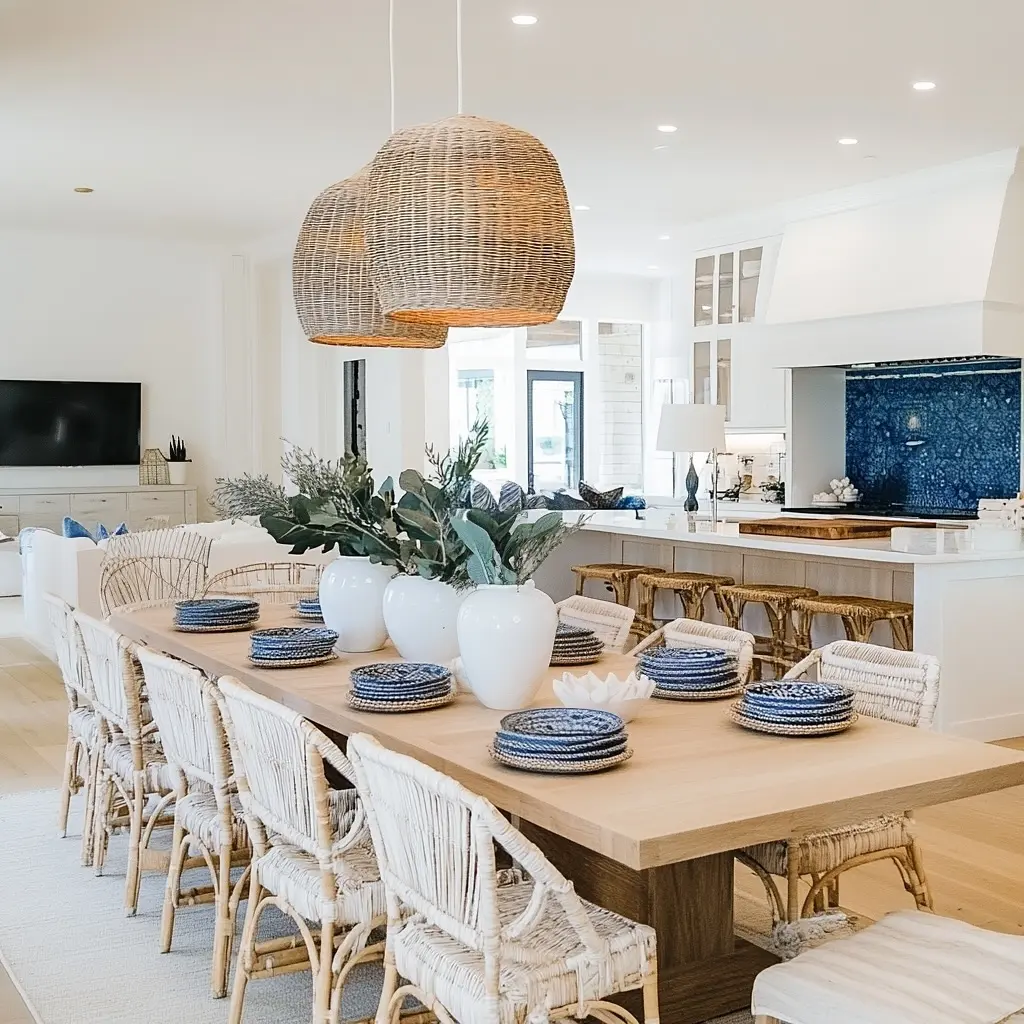
Whether it’s a casual breakfast or a long, lingering dinner, your dining space should invite people to slow down and stay awhile. With coastal decor, the goal is to create a space that feels grounded, natural, and full of light—like a gathering spot just steps from the shore.
Start with the Table as Your Anchor
A solid wood dining table is the heart of a coastal dining room. Look for pieces in driftwood tones, whitewashed finishes, or lightly distressed wood. These textures add depth and tell a story—without feeling too rustic.
Round tables work beautifully in smaller rooms, encouraging conversation. Larger rectangular tables, especially with chunky legs or trestle bases, offer a classic, inviting look.
To soften the space, layer a light runner down the center. Linen or cotton works well and feels unfussy. Choose colors like ivory, pale gray, or a soft ocean blue.
Mix Materials for Depth and Balance
Coastal decor is never too matchy. In fact, mixing materials is one of the best ways to bring warmth and charm to your dining space.
Try pairing your wood table with rattan or cane dining chairs. For a more modern coastal look, consider white or upholstered chairs with clean lines. Want to add a bit of visual interest? Mix two styles of chairs—end chairs in a different material or shape can elevate the look while keeping it casual.
A natural fiber rug—like jute, sisal, or seagrass—can anchor the dining area, especially in an open floor plan. These materials bring texture and durability while staying true to coastal roots. If you’re styling a dining space that flows into your kitchen or living area, you’ll find more ideas in Beach House Perfection: Styling and Furnishing Your Home with Modern Coastal Flair. It’s full of inspiration for pulling together a cohesive coastal look throughout your home.
Lighting That Sets the Mood
The right light fixture pulls everything together. Look for woven pendants, oversized glass globes, or chandeliers with driftwood or shell accents. Your lighting should feel sculptural but not overly ornate.
Make sure the light is warm and soft. Coastal spaces are all about relaxed ambiance, and your dining room should glow—especially in the evenings.
Tabletop Touches That Tell a Story
Keep your tabletop decor minimal but thoughtful. A simple vase of greenery, a bowl of citrus, or a cluster of hurricane candles can set the tone. Look for organic shapes and neutral tones with pops of soft color.
Tableware should follow the same approach—simple, clean, and elegant. Whites, grays, and sandy neutrals work well, with touches of sea-glass green or soft blue for interest.
Coastal Bedroom Decor – Calm, Cozy, and Curated
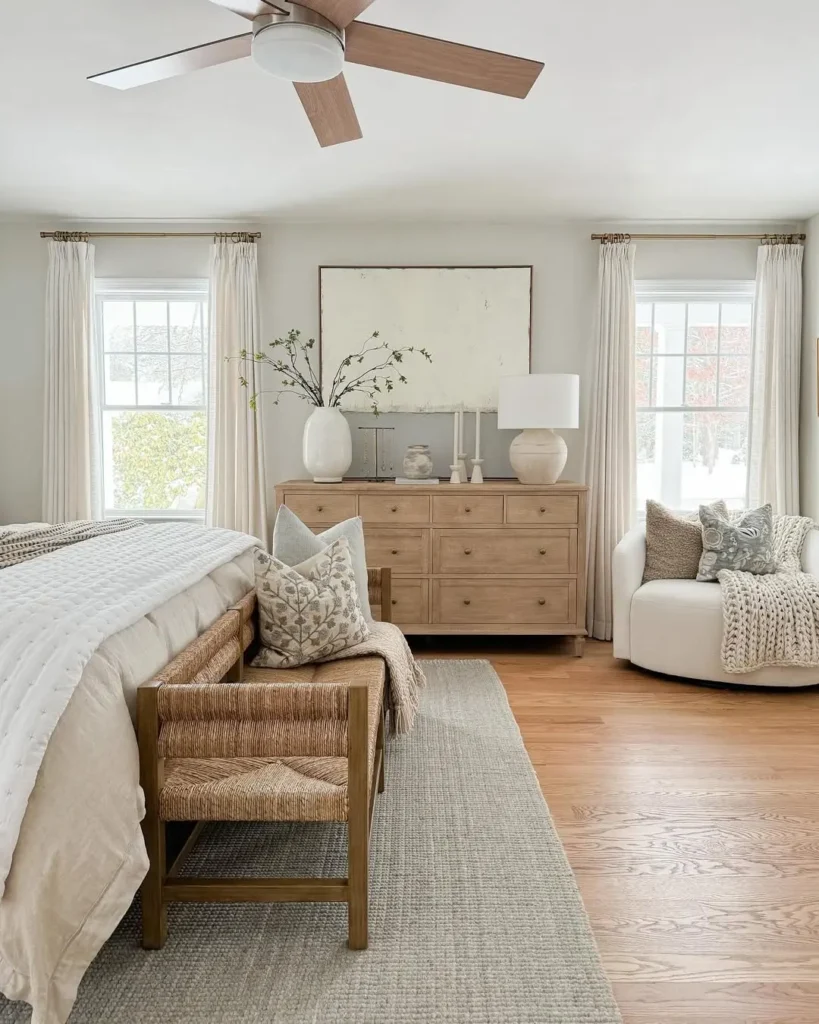
Your bedroom should be your sanctuary—a place where the world quiets down and you can fully exhale. Coastal decor fits beautifully here. It’s soothing, natural, and designed to create a sense of calm. Whether you’re styling a primary suite or a small guest room, the coastal look helps you build a space that feels as restful as a seaside escape.
Choose a Soothing Color Palette
Start with colors that calm your senses. Soft whites, pale blues, misty grays, and sun-bleached neutrals set the tone. These hues bring lightness and help reflect natural light, even in rooms with fewer windows.
Paint is the quickest way to set the mood. Walls in soft ocean tones or warm whites instantly give the room that airy, beach-house feel. Keep trim and ceilings light to help the space feel larger and brighter.
Layer Bedding with Natural Textures
Coastal bedrooms are all about comfort. Layer your bed with lightweight linens, cotton quilts, and relaxed throws. Look for materials that breathe well and invite you to slow down.
Stick to a mostly neutral base and build in soft layers—textured pillows in chambray, seagrass-colored throws, or striped bedding in coastal blues. Don’t overdo the patterns. A few well-chosen details go a long way.
Furnish with Light Woods and Woven Accents
Choose furniture that feels light, both in color and scale. A weathered wood bed frame, a rattan or cane headboard, or a driftwood-style nightstand all work beautifully. You don’t need a full matching set. Coastal style embraces a “collected” feel.
Bring in woven elements through baskets, mirrors, or a bedside pendant light. A jute or wool rug underfoot adds warmth and keeps the space grounded.
Want even more inspiration? Head over to Coastal Chic: Elevate Your Bedroom Decor with Modern Coastal Elements for fresh takes on mixing elegance with seaside charm.
Add Meaningful Decor and Quiet Details
This is your space, so let it reflect your story. A framed beach photo, a small stack of favorite books, or a vase of dried beach grass can say more than a shelf full of trendy decor.
Artwork in a coastal bedroom doesn’t have to be obvious. Abstract ocean tones, minimal line drawings, or soft landscapes all work well. Keep frames simple—natural wood, white, or aged brass.
If your style leans a little more relaxed and bohemian, you’ll love our post on Coastal and Bohemian: Two Styles & One Perfect Bedroom Decor. It’s full of ideas for blending cozy layers with coastal ease.
Coastal Bathroom Decor – Your Private Seaside Sanctuary
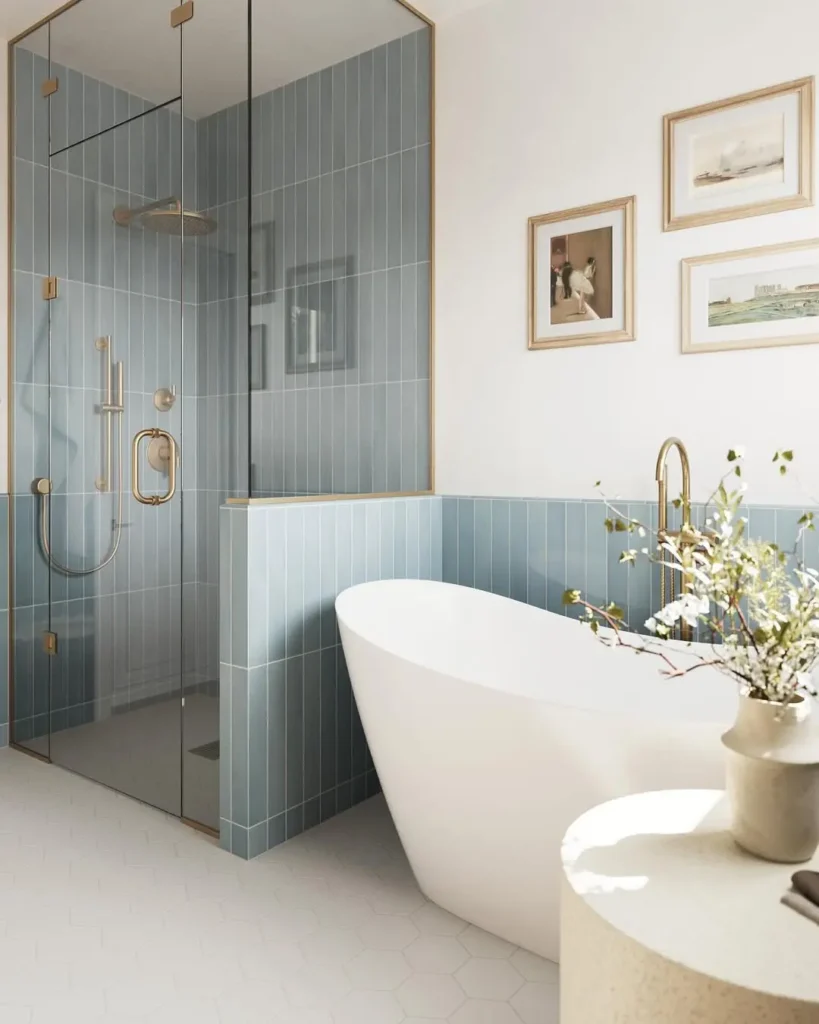
Bathrooms are often overlooked when it comes to decorating, but they’re some of the best spaces to bring in coastal charm. Whether you’re working with a powder room or a full master bath, a few thoughtful touches can transform it into a space that feels calm, fresh, and restorative.
Start with a Clean, Coastal Base
Like any good coastal space, a bathroom should feel light and open. Start with a neutral foundation—white walls, soft blue accents, and clean lines. These choices reflect light and make the space feel larger.
For flooring and wall tile, consider natural stone or classic white subway tile. If you’re adding color, choose soft ocean tones like sea glass green, sky blue, or sandy beige.
Mirrors with wood or rope frames add warmth and texture. Round mirrors or arched shapes soften the room and help balance angular tile or cabinetry.
Add Layers of Texture and Light
Coastal bathrooms shine when you use texture to add depth. Woven baskets, seagrass mats, and rattan accessories introduce natural materials in subtle, practical ways. They also provide extra storage—something every bathroom needs.
Lighting plays a big role here. Look for sconces or pendant lights in weathered metal, ceramic, or glass. Soft, warm lighting helps the space feel more like a spa retreat.
Need some visual inspiration? Check out Coastal Bathroom Decor: 10 Decor Ideas for a Relaxing Oasis—a great resource for pulling together textures, colors, and layout ideas that feel easy and elevated.
Choose Coastal-Inspired Accessories
Small details go a long way in coastal bathrooms. Swap out your towels for soft, oversized ones in white or light gray. Add a wooden stool beside the tub or a small tray for candles and bath salts.
Display a few favorite items: a ceramic soap dish, a shell from your last trip, or a sprig of eucalyptus in a simple vase. The goal isn’t to fill the space, but to add just enough to make it feel personal and lived in.
For a cohesive look, coordinate finishes—like brushed nickel, black, or brass—across faucets, mirrors, and hardware.
Explore Different Coastal Styles
Not all coastal bathrooms need to look the same. Some lean classic, with white and navy accents. Others are more playful, combining natural elements with relaxed, bohemian layers.
If you love a more free-spirited vibe, don’t miss Coastal Boho Bathroom: How to Design a Serene Retreat. It’s filled with ideas for mixing soft colors, vintage touches, and organic materials.
And if you’re looking for a detailed guide on building your bathroom’s entire look, you’ll find what you need in How to Achieve the Perfect Coastal Bathroom Theme.
Coastal Outdoor Living – Bring the Beach Vibes Outside
Outdoor spaces are an extension of your home—and they’re the perfect place to embrace coastal style. Whether you have a cozy front porch, a sunlit balcony, or a backyard deck, you can create an outdoor retreat that feels just as breezy and welcoming as any beachside patio.
Start with the Front Porch
Your front porch is the first glimpse of your home’s personality. With just a few key pieces, you can set a laid-back, coastal tone before guests even step through the door.
Start with seating. A pair of white rocking chairs, woven lounge chairs, or a small bench instantly invites people to sit and stay a while. Add weatherproof pillows in classic coastal patterns—stripes, soft blues, or sandy neutrals.
Layer in texture with an outdoor rug, a couple of planters in aged terracotta or rattan, and a woven doormat. A lantern or two with battery-powered candles adds a soft evening glow.
Need step-by-step styling tips? You’ll love Effortless Ways to Elevate the Charm of Your Coastal Front Porch. It’s packed with ideas to transform your entry in just a few thoughtful moves.
Create a Backyard Coastal Escape
Backyards offer more room to play with layout and comfort. A well-placed seating area—whether it’s a full outdoor sectional or a set of Adirondack chairs—makes the space feel intentional and relaxing.
Use natural materials that can handle the elements. Teak, eucalyptus, and all-weather wicker are great choices for coastal-inspired furniture. Throw in a few outdoor cushions in soft linen or weather-safe canvas to keep it comfy.
String lights, woven pendants, or solar lanterns create ambiance after sunset. A small fire pit, a water feature, or even a simple birdbath can help reinforce the calming, nature-connected feeling of coastal design.
Bring the Style Full Circle
Don’t forget the finishing touches. Outdoor trays, ceramic planters, driftwood sculptures, and coastal-themed art can tie everything together. A small side table with a potted herb or vase of beach grass adds life and detail without being too busy.
If your space allows, consider a hammock or swinging chair. These small luxuries bring serious coastal energy—and make relaxing outside feel effortless.
Coastal Decor for Kids’ Rooms and Multi-Use Spaces
When you’re decorating for real life, it’s important to bring style and function together. That’s especially true in kids’ rooms, play areas, and shared spaces. The beauty of coastal decor is that it’s versatile enough to grow with your family—while still keeping your home feeling calm, light, and pulled together.
Add Whimsy with Coastal Colors and Patterns
Start with a soft color palette, just like in the rest of the home. Pale blues, sandy beiges, warm whites, and touches of sea glass green create a peaceful base. These tones work beautifully in nurseries, big kid rooms, and shared play areas.
Use patterns that feel playful but not too busy. Think wide stripes, subtle wave motifs, or animal prints with a coastal twist (like turtles, whales, or starfish). A striped area rug, shell-printed bedding, or a framed watercolor adds interest without overwhelming the space.
You can also layer in soft wallpaper or a mural on one accent wall. Choose something light and dreamy—like a seascape, clouds, or gentle palm silhouettes—to give the space a sense of wonder.
Choose Practical, Beachy Furnishings
Furniture in these rooms should be durable, adaptable, and easy to love. White-painted wood, light oak, or natural bamboo pieces work well and coordinate easily with the rest of your home’s coastal palette.
Opt for beds and dressers with simple lines and storage built in. Open shelving or cubbies in rattan or canvas bins make clean-up a breeze—plus they add texture and style.
Add a cozy reading nook with a bean bag chair, pouf, or mini hammock. A rattan swing chair or canopy tent can turn a corner into a calming retreat that kids adore.
Decorate with Intention and Personality
This is where you can bring in more playful coastal elements. Hang a surfboard on the wall (even a mini one), display a collection of beach treasures, or use oversized letters to spell out a beachy word like “surf,” “dream,” or “breathe.”
Artwork can be bold or soft, depending on the mood you want to create. Mix framed prints with handmade crafts or found objects to add heart and character.
Looking for inspiration that blends relaxed, collected charm with a coastal twist? Our post Coastal and Bohemian: Two Styles & One Perfect Bedroom Decor has plenty of ideas that work wonderfully in shared family spaces.
Styling Tips to Tie It All Together
Now that we’ve explored how to bring coastal decor into every room, let’s talk about how to make it all flow. A well-designed home feels intentional and connected—but never overly matched. The beauty of coastal style is that it lets you mix, layer, and evolve your space while still keeping that breezy, beach-inspired charm throughout.
Stick to a Consistent Color Story
Start with your core palette. Choose three to five soft, coastal-inspired shades that work well together—like crisp white, seafoam green, driftwood gray, pale blue, and sandy beige. Then carry those tones from room to room.
You don’t have to use them in the same way each time. One room might have a soft blue wall, while another uses blue in a throw pillow or artwork. The key is subtle repetition. It helps your home feel harmonious and thoughtfully pulled together.
Mix Textures, Not Themes
It’s easy to go overboard with coastal “themes,” but the best coastal homes are more about feeling than objects. Instead of filling your home with anchors, seashells, and beach signs, focus on textures that evoke the coast.
Think woven baskets, driftwood furniture, linen curtains, sea glass accents, and ceramic pieces with a hand-touched feel. These elements speak to the natural, casual beauty of the coast—without being too on-the-nose.
Layer Decor with Intention
Less is often more with coastal style. Let your decor breathe. Leave some negative space on walls and shelves. This creates a sense of openness and calm, even in smaller rooms.
When adding accessories, group them in odd numbers and vary the heights. A simple trio—like a candle, a small vase, and a piece of coral—can make a big impact when styled thoughtfully on a tray or console.
Remember, your home should feel collected over time, not decorated all at once.
Balance Light and Warmth
Natural light is essential in coastal homes, but lighting also plays a role in setting the mood. Use sheer curtains to filter sunlight during the day, and layer in soft, warm bulbs for evening.
In rooms with less natural light, mirrors can help bounce brightness around. Choose mirrors with frames that match your coastal palette—whitewashed wood, woven rattan, or antique brass all work beautifully.
If you need help choosing mirrors that reflect your style (and your space), take a look at How to Add Mirrors to Your Coastal Decor. It’s full of tips to help you reflect light and elevate your rooms with ease.
Let Your Story Shine Through
The most memorable homes are the ones that reflect the people who live there. Coastal style is about slowing down and connecting—with nature, with loved ones, and with yourself. So add the things that bring you joy.
A framed photo from your favorite beach vacation. A shell collected on a morning walk. A handwritten recipe from your grandmother tucked into the corner of your kitchen. These details are what turn a house into a home.
Conclusion – Embrace the Calm of Coastal Living
Coastal decor is more than a design style—it’s a way to create calm, light-filled spaces that feel lived-in and loved. From entryways to outdoor patios, this guide has shown how simple choices in color, texture, and layout can turn every room into a retreat.
The beauty of coastal design lies in its flexibility. Whether you lean classic, modern, or a little boho, there’s room to make it your own. Start small. Stay true to what feels good. Let your home tell your story.
And when you’re ready for more inspiration, explore the related posts linked throughout this guide. Each one offers fresh ideas to help you keep the coastal charm flowing.
Frequently Asked Questions
What’s the difference between coastal decor and nautical decor?
Coastal decor is inspired by the feeling of being near the sea—think soft colors, natural textures, and breezy light. Nautical decor is more theme-driven, often using anchors, navy stripes, and rope accents. Coastal is relaxed and subtle, while nautical tends to be more bold and decorative.
Can I mix coastal decor with other design styles?
Absolutely. Coastal decor plays well with many styles—like farmhouse, bohemian, modern, and even minimalist. The key is to keep your palette light, use natural textures, and layer in meaningful pieces that reflect your personality. It’s all about creating a space that feels effortless and uniquely yours.
Can I decorate with coastal style on a budget?
Yes! Coastal design is all about simplicity. Use what you have—paint in light colors, bring in natural textures, repurpose baskets, and shop secondhand. A few well-chosen pieces can create a beautiful coastal feel without spending a lot.

